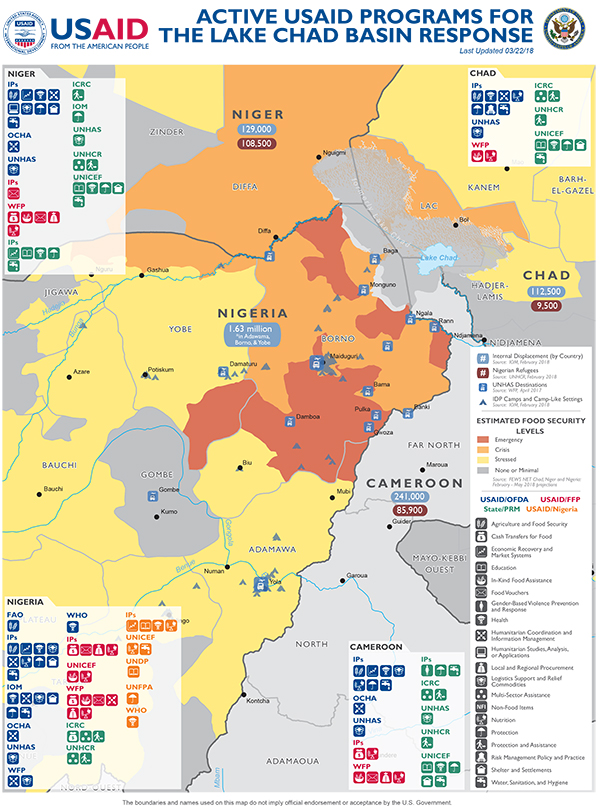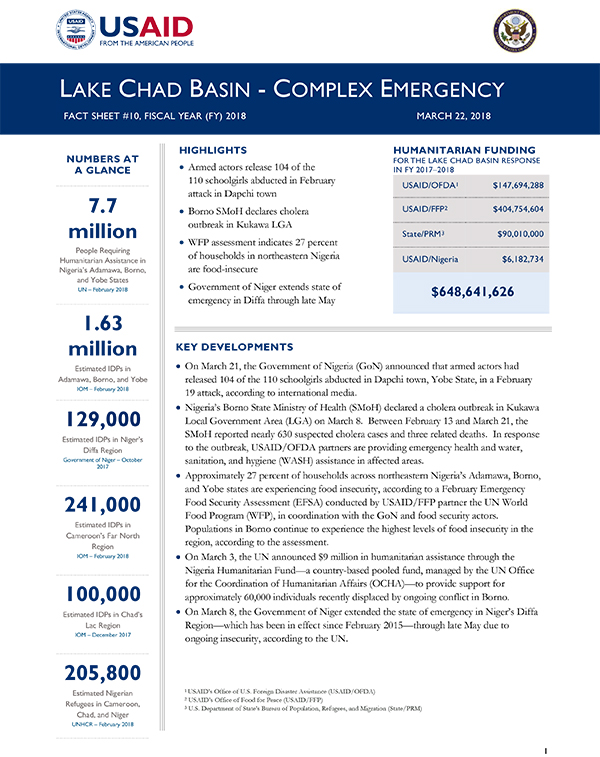- What We Do
- Agriculture and Food Security
- Democracy, Human Rights and Governance
- Economic Growth and Trade
- Education
- Environment and Global Climate Change
- Gender Equality and Women's Empowerment
- Global Health
- Humanitarian Assistance
- Transformation at USAID
- Water and Sanitation
- Working in Crises and Conflict
- U.S. Global Development Lab
Speeches Shim
March 22, 2018
Highlights
Armed actors release 104 of the110 schoolgirls abducted in Februaryattack in Dapchi town
Borno SMoH declares choleraoutbreak in Kukawa LGA
WFP assessment indicates 27 percentof households in northeastern Nigeriaare food-insecure
Government of Niger extends state of emergency in Diffa through late May
Lake Chad Map - 03-22-2018 ![]() (pdf - 590k)
(pdf - 590k)
Numbers At A Glance
7.7 million
1.63 million
129,000
241,000
100,000
205,800
Humanitarian Funding
For the Lake Chad Basin Response
| USAID/OFDA | $147,694,288 |
| USAID/FFP | $404,754,604 |
| State/PRM | $90,010,000 |
| USAID Nigeria | $6,182,734 |
| Total | $648,641,626 |
Lake Chad Basin Complex Emergency Fact Sheet #10 ![]() (pdf - 279k)
(pdf - 279k)
KEY DEVELOPMENTS
On March 21, the Government of Nigeria (GoN) announced that armed actors hadreleased 104 of the 110 schoolgirls abducted in Dapchi town, Yobe State, in a February19 attack, according to international media.
Nigeria’s Borno State Ministry of Health (SMoH) declared a cholera outbreak in KukawaLocal Government Area (LGA) on March 8. Between February 13 and March 21, theSMoH reported nearly 630 suspected cholera cases and three related deaths. In responseto the outbreak, USAID/OFDA partners are providing emergency health and water,sanitation, and hygiene (WASH) assistance in affected areas.
Approximately 27 percent of households across northeastern Nigeria’s Adamawa, Borno,and Yobe states are experiencing food insecurity, according to a February EmergencyFood Security Assessment (EFSA) conducted by USAID/FFP partner the UN WorldFood Program (WFP), in coordination with the GoN and food security actors.Populations in Borno continue to experience the highest levels of food insecurity in theregion, according to the assessment.
On March 3, the UN announced $9 million in humanitarian assistance through theNigeria Humanitarian Fund—a country-based pooled fund, managed by the UN Officefor the Coordination of Humanitarian Affairs (OCHA)—to provide support forapproximately 60,000 individuals recently displaced by ongoing conflict in Borno.
On March 8, the Government of Niger extended the state of emergency in Niger’s DiffaRegion—which has been in effect since February 2015—through late May due toongoing insecurity, according to the UN.
NIGERIA
On March 21, the GoN announced that armed actors had released 104 of the 110 schoolgirls abducted from the Government Girls Science and Technical College on February 19, according to international media. The mid-February attack and abduction resulted in at least five deaths, according to some of the released students.
The Borno SMoH declared a cholera outbreak in Kukawa LGA on March 8. Between February 13—when the SMoH recorded the first laboratory-confirmed cholera case in Kukawa—and March 21, health actors reported nearly 630 suspected cholera cases and three related deaths in Kukawa’s Baga, Doro, and Kukawa wards, according to the SMoH. Health actors recorded the majority of cases during March in Doro, while the SMoH has not reported a case in Kukawa ward since March 8. To date, the SMoH has confirmed 23 cases of cholera in the LGA.
USAID/FFP partner WFP, in collaboration with the GoN and food security actors, conducted a February EFSA of 20,000 households across 62 LGAs in Adamawa, Borno, and Yobe. The assessment found that approximately 27 percent of households are experiencing food insecurity, including 3 percent of households who are severely food-insecure. The EFSA notes that food insecurity affects displaced households more than host community households—with 42 percent and 23 percent affected by food insecurity, respectively—and severe food insecurity is higher among internally displaced persons (IDPs). Borno continues to account for the worst levels of food insecurity in the region with 40 percent of households in the state identified as food-insecure.
Despite acute levels of need, WFP reports that food security conditions in Adamawa, Borno, and Yobe have continued to improve since early 2017, with the overall food-insecure population decreasing by 18 percent compared to February 2017. In addition, the proportion of food-insecure displaced households decreased from 51 percent in October 2017 to 41 percent in the February assessment. The EFSA identified humanitarian assistance, increased access to land among IDPs, and livelihood support as potential factors contributing to improved conditions.
A USAID/FFP non-governmental organization (NGO) partner reached approximately 160,000 people in Borno with cash-based and in-kind food assistance in February. The partner also conducted nutrition screenings for approximately 600 pregnant or lactating women (PLW) and 700 children ages five years and younger, health education sessions on antenatal care for more than 500 PLWs and 40 community members, and hygiene promotion sessions for more than 200 PLWs.
In January, the Monitoring and Reporting Mechanism (MRM) on grave violations of children's rights in situations of armed conflict—mandated by UN Security Council Resolution 1612 and led by the UN Children’s Fund (UNICEF)—recorded 23 violations affecting nearly 80 children in Nigeria. The MRM identified the maiming or killing of children as the top reported violation during the month, resulting in 53 child casualties, followed by abductions and the recruitment or use of children by armed groups, including the use of eight girls as carriers of improvised explosive devices (IEDs). The majority of violations occurred in Borno—accounting for 76 percent of reported cases—while Adamawa accounted for the remaining 24 percent of cases.
On March 10, the Nigerian military expressed concern about the presence of unexploded ordnance in northeastern Nigeria, which pose significant protection risks to civilian populations. IEDs located on agricultural land, paths, and roads have resulted in civilian deaths in Borno and Yobe in recent months, the UN reports. On March 6, local residents in Borno’s Dikwa LGA encountered an IED while gathering firewood, resulting in at least seven civilian deaths. Relief actors have called for demining activities across affected areas in northeastern Nigeria to mitigate the risk of death or injury due to IEDs.
On March 12, NGO Refugees International (RI) released a report assessing the viability of a GoN plan to relocate IDPs from displacement sites in Borno’s capital city of Maiduguri to Borno’s town of Bama. RI reports that conditions in Bama are not conducive to IDP returns due to insecurity and a lack of basic services; as such, RI called on the GoN to refrain from facilitating large-scale IDP returns to Bama in the near term. RI also expressed concern about recent statements by the Governor of Borno indicating intentions to close IDP camps in the state by May.
RI underscored the need for the GoN to develop a comprehensive plan for IDP returns in advance of any large-scale return efforts, including the need for GoN authorities to outline logistical requirements, prerequisite security conditions in areas of planned returns, and plans to address housing, land, and property issues. RI also highlighted the need for the UN and NGOs to support information-gathering efforts on IDP return intentions and increase civil-military coordination, as well as analysis of IDP and returnee movement restrictions.
On March 3, the UN, through the Nigeria Humanitarian Fund, announced $9 million in additional funding to provide emergency assistance to approximately 60,000 people recently displaced by ongoing conflict in Borno. The funding will support 15 relief projects and includes $2 million to support the UN Humanitarian Air Service (UNHAS), which provides relief cargo and staff transport across northeastern Nigeria. In particular, the funding will support rapid humanitarian response efforts in areas recently affected by large-scale displacement, including northern Adamawa, eastern Borno along the Cameroon border, and northern Borno—where nearly 30,000 newly displaced individuals require food, health care services, shelter, and WASH assistance.
CAMEROON
Displaced and vulnerable households in Cameroon’s Far North Region are expected to face Stressed—IPC 2—levels of food insecurity through September, according to the Famine Early Warning Systems Network (FEWS NET). Below-average seasonal rainfall and poor crop production, combined with protracted population displacement and insecurity, will likely worsen food insecurity conditions among IDPs and vulnerable populations in Far North over the coming months. FEWS NET projects that some populations in the region could face restricted access to food, increased food prices, and limited income-generating opportunities during the same period. Between April and September, anticipated deliveries of humanitarian assistance will likely prevent some poor households from experiencing Crisis—IPC 3—levels of acute food insecurity, although more severe levels remain possible, FEWS NET reports.
In February, USAID/FFP partner WFP provided emergency food assistance to approximately 48,200 Nigerian refugees in Far North. Additionally, WFP provided school meals to 69,000 children and conducted acute malnutrition prevention activities, such as blanket supplementary feeding programs, for 34,000 children ages five years and younger in conflict-affected communities.
CHAD
Vulnerable populations in Chad’s Lac Region will likely continue to face Crisis levels of acute food insecurity through September, FEWS NET reports. The organization expects weak household food supplies, rising cereal prices, decreasing income from labor and livestock sales, and declining milk availability to undermine household food consumption between February and May, while ongoing conflict, decreased agricultural production and incomes, emptied grain stores, and generally poor socio-economic conditions will drive Crisis levels of acute food insecurity between June and September. Starting in September, food security conditions may improve moderately in Lac as harvesting commences and income-generating opportunities increase, though FEWS NET anticipates that some populations will remain in Crisis.
NIGER
A USAID/OFDA partner reports that insecurity remains the primary challenge to program implementation in Diffa, particularly in Toumour following attacks in the area in recent months. Despite security-related challenges, the partner continued to deliver emergency WASH and economic recovery assistance in Diffa’s Toumour commune in February. During the month, the partner trained 15 masons on emergency latrine design in the town of Toumour. In addition, the partner trained nearly 70 community members on hygiene promotion practices, while constructing 10 latrines in the town.
To bolster livelihoods among conflict-affected individuals in Toumour, the USAID/OFDA partner is also implementing cash-for-work (CFW) activities. In February, the organization identified 600 people to participate in CFW programs; the organization plans to work with the Government of Niger Departmental Directorate for the Environment to train CFW participants and conduct quality assurance monitoring of CFW programs.
CONTEXT
Years of conflict perpetuated by Boko Haram and Islamic State of Iraq and Syria–West Africa have triggered a humanitarian crisis in Nigeria and surrounding countries in the Lake Chad Basin region, including areas of Cameroon, Chad, and Niger. The escalating violence—including deliberate attacks on civilians and relief workers—has displaced more than 2 million people; hindered agricultural production, livelihoods, and cross-border trade; prevented delivery of humanitarian assistance; and restricted affected populations from accessing basic services in the four countries.
The UN estimates that nearly 11 million people in the region require humanitarian assistance, including approximately 7.7 million people in northeastern Nigeria’s three most-affected states—Adamawa, Borno, and Yobe. Populations in the Lake Chad Basin remain highly dependent on emergency food assistance to meet basic food needs, in addition to requiring emergency health, nutrition, protection, shelter, and WASH interventions.
On November 10, 2016, USAID activated a Disaster Assistance Response Team (DART) to lead the U.S. Government response to the humanitarian crisis in northeastern Nigeria. USAID also stood up a Washington, D.C.-based Response Management Team to support the DART.
U.S. Chargé d’Affaires, a.i., Matthew D. Smith, U.S. Ambassador Geeta Pasi, U.S. Chargé d’Affaires, a.i., Phillip Nelson, and U.S. Ambassador W. Stuart Symington have re-declared disasters for FY 2018 due to the ongoing complex emergencies and humanitarian crises in Cameroon, Chad, Niger, and Nigeria, respectively.



Comment
Make a general inquiry or suggest an improvement.